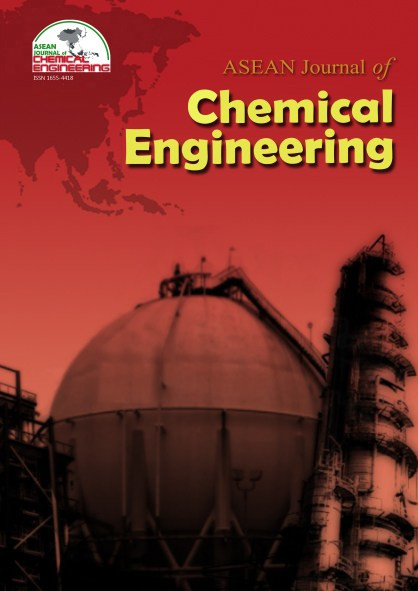Stepwise Methanolysis of Waste Cooking Oil Using Immobilized Thermomyces lanuginose Lipase within Ultrasonic-assisted Condition
Abstract
Biodiesel or fatty acid methyl ester is a fuel derived from vegetable oil and animal fat. In this study, biodiesel is produced from transesterification of waste cooking oil and methanol (methanolysis), using immobilized Thermomyces lanuginose (TLIM) within ultrasonic-assisted conditions. The enzymatic transesterification is used due to environmental concerns and also the high yield of biodiesel. The limitations in the mass transfer rate of the product and longer reaction time have drawn attention to more efficient technology. One of them is ultrasonic-assisted to reduce reaction time and increase the catalytic activity of the enzyme. Various parameters have been examined in this study, such as reaction time, methanol to oil ratio, the effect of temperatures, and temperature dependency of immobilized Thermomyces lanuginose (TLIM). The highest biodiesel yield of 69.3% was obtained after 6 hours of reaction at a temperature of 35°C and using three step-wise addition of methanol to oil ratio 3:1. Our study showed that the TLIM is sensitive to methanol to oil molar ratio above 1:1. Further research on the temperature dependence found that the TLIM activation energy in the reaction is 11.9 kcal/mol, which is within activation energy for an enzymatic reaction.
References
2. Carlos A., G. F., Andrés, G.-R., & Fabio E., S. (2011). Biodiesel Production from Waste Cooking Oil. Biodiesel - Feedstocks and Processing Technologies, 7(12), 23–43. https://doi.org/10.5772/25313
3. Gharat, N., & Rathod, V. K. (2013). Ultrasound assisted enzyme catalyzed transesterification of waste cooking oil with dimethyl carbonate. Ultrason. Sonochem., 20(3), 900–905. https://doi.org/10.1016/j.ultsonch.2012.10.011
4. Ji, J., Wang, J., Li, Y., Yu, Y., & Xu, Z. (2006). Preparation of biodiesel with the help of ultrasonic and hydrodynamic cavitation. Ultrason., 44(SUPPL.). https://doi.org/10.1016/j.ultras.2006.05.020
5. Lam, M. K., Lee, K. T., & Mohamed, A. R. (2010). Homogeneous, heterogeneous and enzymatic catalysis for transesterification of high free fatty acid oil (waste cooking oil) to biodiesel: A review. Biotechnol. Adv., 28(4), 500–518. https://doi.org/10.1016/j.biotechadv.2010.03.002
6. Ma, F., & Hanna, M. A. (1999). Biodiesel production: A review. Biores. Technol., Vol. 70, pp. 1–15. https://doi.org/10.1016/S0960-8524(99)00025-5
7. Mandolesi De Araújo, C. D., De Andrade, C. C., De Souza E Silva, E., & Dupas, F. A. (2013). Biodiesel production from used cooking oil: A review. Renewable Sustainable Energy Rev., 27, 445–452. https://doi.org/10.1016/j.rser.2013.06.014
8. Moazeni, F., Chen, Y. C., & Zhang, G. (2019). Enzymatic transesterification for biodiesel production from used cooking oil, a review. J. Cleaner Prod., 216, 117–128. https://doi.org/10.1016/j.jclepro.2019.01.181
9. Musa, I. A. (2016). The effects of alcohol to oil molar ratios and the type of alcohol on biodiesel production using transesterification process. Egypt. J. of Pet., 25(1), 21–31. https://doi.org/10.1016/j.ejpe.2015.06.007
10. Nelson, L. a, Foglia, T. a, & Marmer, W. N. (1996). Lipase-catalyzed production of biodiesel. Journal of the American Oil Chemists Society, 73(8), 1191–1195. https://doi.org/10.1007/BF02523383
11. Shuler, M. L., & Kargi, F. (2002). Bioprocess Engineering Basic Concepts (THE PHYSIC). https://doi.org/10.1016/0168-3659(92)90106-2
12. Šibalić, D., Šalić, A., Tušek, A. J., Sokač, T., Brekalo, K., Zelić, B., … Tišma, M. (2020). Sustainable Production of Lipase from Thermomyces lanuginosus : Process Optimization and Enzyme Characterization . Ind. Eng. Chem. Res., 2–12. https://doi.org/10.1021/acs.iecr.0c04329
13. Sreedhar, I., & Kirti, Y. (2016). Process standardization and kinetics of ethanol driven biodiesel production by transesterification of ricebran oil. Int. J. of Ind. Chem., 7(2), 121–129. https://doi.org/10.1007/s40090-016-0074-z
14. Vela, M. A. F., Acevedo-Páez, J. C., Urbina-Suárez, N., Basto, Y. A. R., & González-Delgado, Á. D. (2020). Enzymatic transesterification of waste frying oil from local restaurants in east colombia using a combined lipase system. Applied Sciences (Switzerland), 10(10). https://doi.org/10.3390/app10103566
15. Vijayan, G. (2013). Enzymatic Transesterification of Fish Oil for the Production of Biodiesel. (November).
16. Yaakob, Z., Mohammad, M., Alherbawi, M., Alam, Z., & Sopian, K. (2013). Overview of the production of biodiesel from Waste cooking oil. Renewable Sustainable Energy Rev., 18, 184–193. https://doi.org/10.1016/j.rser.2012.10.016
17. Yan, J., & Yan, Y. (2017). Biodiesel Production and Technologies. In Encyclopedia of Sustainable Technologies (Vol. 3). https://doi.org/10.1016/B978-0-12-409548-9.10110-1
Copyright holder for articles is ASEAN Journal of Chemical Engineering. Articles published in ASEAN J. Chem. Eng. are distributed under a Creative Commons Attribution-NonCommercial 4.0 International (CC BY-NC 4.0) license.
Authors agree to transfer all copyright rights in and to the above work to the ASEAN Journal of Chemical Engineering Editorial Board so that the Editorial Board shall have the right to publish the work for non-profit use in any media or form. In return, authors retain: (1) all proprietary rights other than copyright; (2) re-use of all or part of the above paper in their other work; (3) right to reproduce or authorize others to reproduce the above paper for authors’ personal use or for company use if the source and the journal copyright notice is indicated, and if the reproduction is not made for the purpose of sale.



